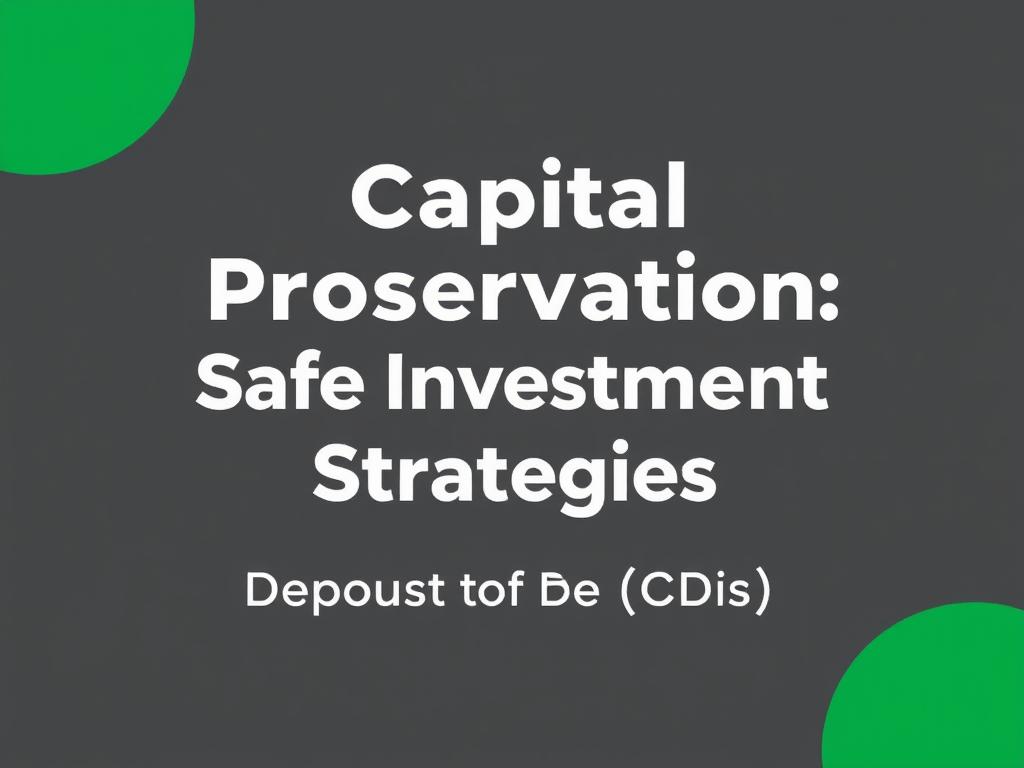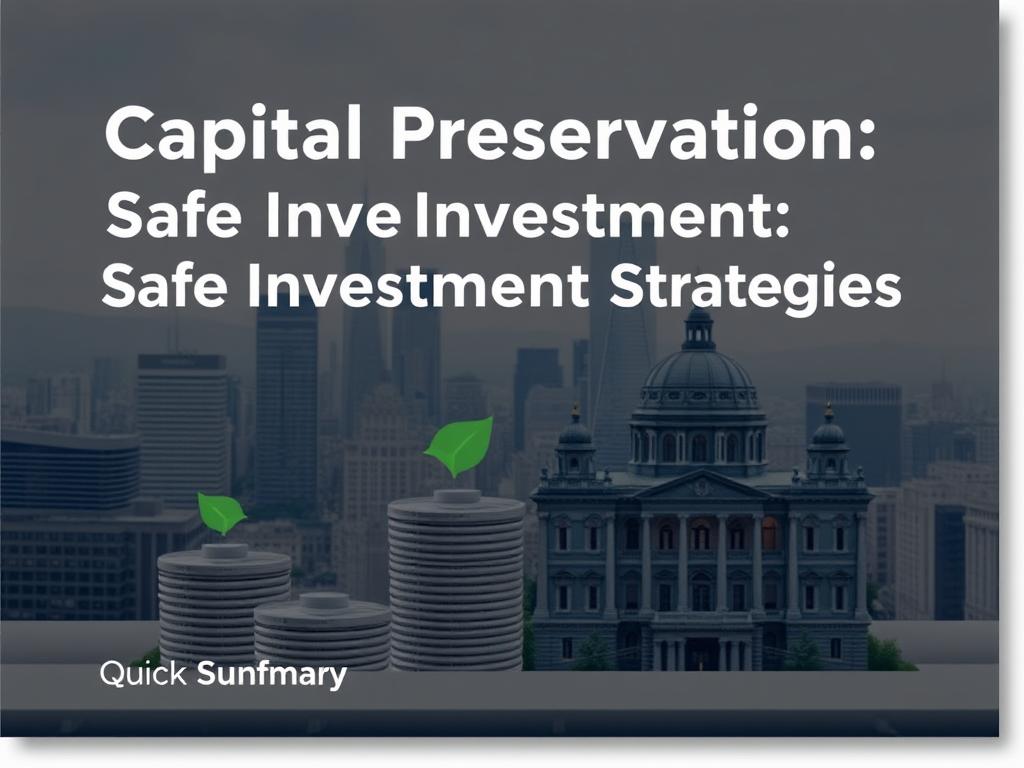Capital Preservation: Safe Investment Strategies to Protect Your Wealth
When it comes to managing your money, the idea of capital preservation is essential, especially if your main goal is to protect your savings rather than chase high returns. Capital preservation simply means investing in ways that minimize the risk of losing your initial investment. In uncertain economic times or as you approach retirement, this strategy becomes particularly important. But what exactly are the best safe investment strategies to help you safeguard your funds without sacrificing too much growth? In this article, we’ll explore the ins and outs of capital preservation and share practical investment options that emphasize safety and steady income.
Understanding Capital Preservation and Its Importance
Capital preservation is the cornerstone of any conservative investment approach. It focuses on maintaining your principal amount intact over time, which can sometimes mean accepting lower returns. Unlike aggressive investments that fluctuate widely, capital preservation prioritizes stability. This strategy is ideal for investors nearing retirement, those with short-term financial goals, or anyone who cannot afford to see their savings significantly reduced.
Why is it so essential? Imagine you’ve worked hard your entire life and saved a nest egg for your retirement. If you lose a large chunk of that money due to risky investments, it takes much more effort to recover than simply focusing on protecting that principal amount. The famous saying, “It’s not how much you make but how much you keep,” directly applies here. Prioritizing capital preservation helps ensure financial security and peace of mind.
Key Investment Options for Capital Preservation
Now that you understand the concept, let’s dive into some safe investment strategies often favored for capital preservation. These options tend to have lower volatility and provide reliable income streams or guaranteed returns.
1. High-Quality Government Bonds
Government bonds are among the safest investments you can make because they are backed by the “full faith and credit” of the government. Treasury bonds, especially those issued by stable countries like the United States, offer steady interest payments over fixed periods. Although returns might be modest compared to stocks, government bonds shield your capital from market downturns.
2. Certificates of Deposit (CDs)

CDs are fixed-term deposits offered by banks with a guaranteed interest rate. They’re federally insured up to a certain amount and protect your initial deposit, making them a classic choice for conservative investors. The downside is that your money is locked in for specific periods, which can range from a few months to several years.
3. Money Market Funds

Money market funds pool investors’ money to buy short-term, high-quality securities like Treasury bills and commercial paper. They aim to maintain a stable net asset value and provide liquidity, meaning you can access your money easily while earning a bit of interest. These funds tend to have very low risk but also lower returns.
4. Dividend-Paying Blue-Chip Stocks
While stocks generally carry higher risk, certain dividend-paying blue-chip companies offer a relatively stable income stream and can act as part of a capital preservation strategy, especially when combined with other safer investments. These companies have a history of weathering economic downturns and often increase dividends over time, providing protection against inflation.
Balancing Risk and Return: How to Construct a Capital Preservation Portfolio
One of the most crucial elements in capital preservation is portfolio diversification. Spreading your investments across different asset classes can reduce risk and improve the chances of maintaining your principal. Here’s a simple example of how a capital preservation portfolio might be structured:
| Asset Class | Allocation Percentage | Purpose |
|---|---|---|
| Government Bonds | 50% | Stable returns and capital safety |
| Certificates of Deposit | 20% | Guaranteed principal and steady interest |
| Money Market Funds | 15% | Liquidity and very low risk |
| Dividend-Paying Blue-Chip Stocks | 15% | Income and growth potential with moderate risk |
This allocation offers a solid foundation to protect your capital while still enabling some growth. Of course, your personal situation, risk tolerance, and financial goals should dictate your specific allocation. Consulting with a financial advisor can help tailor this to your needs.
Additional Tips to Ensure Capital Preservation
Beyond selecting safe investment vehicles, there are other practical strategies to enhance capital preservation:
- Reinvest dividends and interest: This helps your money grow, offsetting inflation over time.
- Review your portfolio regularly: Markets change, and your portfolio should evolve to maintain safety and align with your goals.
- Consider laddering investments: Staggering maturity dates for CDs and bonds can improve liquidity without sacrificing safety.
- Stay informed about economic conditions: Understanding interest rates, inflation, and market risks helps you make better decisions.
Common Misconceptions About Capital Preservation
Some people believe that capital preservation means you can’t grow your wealth, but that’s not entirely true. While it is more cautious, it’s about preserving your funds with a reasonable rate of return and avoiding devastating losses. Another myth is that all safe investments offer below-inflation returns. Although some do, combining different safe assets can often beat inflation over time.
Quick Summary of Investments for Capital Preservation

| Investment Type | Risk Level | Typical Return | Liquidity |
|---|---|---|---|
| Government Bonds | Low | 2%-4% (varies) | Moderate to High |
| Certificates of Deposit | Low | 1%-3% | Low (until maturity) |
| Money Market Funds | Very Low | 0.5%-2% | High |
| Dividend-Paying Stocks | Moderate | 3%-6% + potential capital gains | High |
Conclusion
Capital preservation is a vital element of smart investing, particularly when protecting your existing wealth is more important than chasing high returns. By focusing on safe investment strategies such as government bonds, certificates of deposit, money market funds, and selected dividend-paying stocks, you can build a portfolio that withstands market turbulence and provides steady income. Remember, the key to successful capital preservation lies in diversification, staying informed, and aligning your investment choices with your individual needs and financial goals. With careful planning and prudent decisions, preserving your capital is not only achievable but can also form a stable foundation for your financial future.







